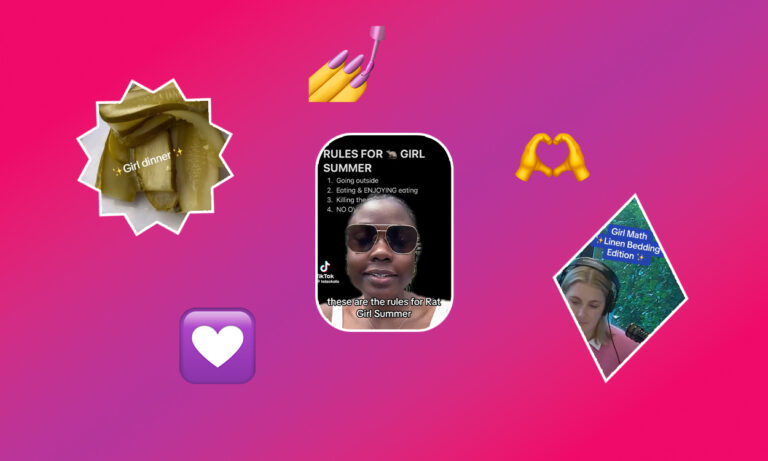The girls are using maths and dinner to redefine womanhood, one TikTok trend at a time

In the vast landscape of the internet, a peculiar trend has recently emerged: the ubiquitous use of the word ‘girl’. From ‘girl dinner’, Tube Girl and ‘rat girl summer’ to ‘lazy girl jobs’, ‘girl maths’, ‘sad girl novel’ and several other made-up fashion and beauty microtrends, the word girl is all over the internet right now. But behind this trend lies a deeper sentiment. Girl trends shape different parts of our world—everything from beauty and fashion to work and lifestyle—and the women at the heart of these aesthetics and subcultures are tastemakers and creators of mass culture.
@gracestamariaa my girl dinner x
♬ original sound - Karma Carr
@fvhzm #itsbasicallyfree but it's also basically a secondary income 💁♀️ Let us know if you need us to #girlmath one of your purchases! 🤪
♬ original sound - FVHZM
“Overlooked consumers, primarily young women, are powerful tastemakers. Their influence can be seen in the rise of various trends. These aren’t just passing fads; they’re evidence of the collective power and influence that [this] particular demographic have on society,” says Bayu Prihandito, a certified psychology consultant, life coach, and founder of Life Architekture, a platform dedicated to guiding individuals towards a life with meaning.
Megan Thee Stallion’s 2019 track ‘Hot Girl Summer’ may have had a little something to do with the whole girl trend phenomenon. This call to action anthem became a self-affirming sensation that young women could get behind. Firstly, it gave them a sense of empowerment and it was a much-needed confidence booster. Secondly, the premise of it was simple yet effective—it allowed gen Z and millennial women to step forth into a summer that was carefree, serendipitous, and one where they were in charge of their happiness.
Since Stallion unleashed this vibe shift upon the world, girl trends have become a powerful cultural force that shapes how young women take up space in society. “This ‘girlification’ is not just about aesthetics or fashion, it goes way deeper,” notes Prihandito. “Historically, ‘girl’ trends were often dismissed as being shallow, irrelevant, or superficial. But what you get in reality is that these trends often serve as a reflection of societal shifts and values.”
Notably, the majority of those engaging with girl content are gen Z and millennial women, not girls themselves. This observation reveals a subtle subtext; the implication that young women are merely girls, and as a consequence, their interests and experiences aren’t to be taken seriously. “We know that language matters. It’s why we make concerted efforts to refer to those around us as ‘women’ and not ‘girls.’ But that’s also probably why for some it feels regressive to see the term ‘girls’ being used in a playful way across social media,” says Anna Waletzko, behavioural analyst at cultural intelligence and research agency Canvas8.
The internet’s fervour for applying the girl label to just about everything was bound to reveal a subtle gendered prejudice. But as the women behind these trends start to speak out against the stereotypes used to constrain or belittle them, the girlification of culture has become a way for them to push back and restore their cultural power.
A lot of the time, it can seem as if gen Zers ascribe their identity to a certain look or aesthetic—something that hasn’t escaped the eyes of girl trend followers. Whether that’s ‘vanilla girl’, ‘tomato girl’, ‘coastal cowgirl’ or ‘baked beans girl’, many of these digital-based girl trends have worked their way off screens into the real world as they capture the hearts and minds of dedicated fan bases. The girl trend takeover is well and truly happening, and there’s no way of stopping it.
@marysherb tomato girl makeup tutorial 🫶 #tomatogirl #tomatogirlmakeup #makeupaesthetic
♬ bad girls instrumental - 𝐄𝐃𝐈𝐓𝐀𝐔𝐃𝐗𝐒 ~ 🎧
The TikTok girlies and the echo chamber of the internet may be partially to blame for this, but as girl trends offer their own version of girlhood, it’s a sign of the duality of modern women. This is more than ballet flats and bows. Girl trends free women from the idea that traditional societal structures are something they should be reaching for, and instead allow them to come together en masse in a way that best suits them.
@screenshothq Asking boyfriends how often they think about the Roman Empire has been the latest trend to go viral, with the answers taking everyone by surprise. But it’s got women thinking, what is the female equivalent to the Roman Empire? Is it the Titanic? Is it Princess Diana? Or is it that ICONIC Gossip Girl Thanksgiving moment? 😉 Welcome back to Episode 22 of Reel Talk, a weekly series where we break down provocative and reactive viral videos, serving bold commentary every week 🌶️ #romanempire #thetitanic #theromanovs #gossipgirl #princessdiana #thetudors #romanempiretrend
♬ Lo-fi hip hop - NAO-K
As the internet has become undoubtedly girl-obsessed, we find ourselves at a crossroads. Yes, branding various phenomena as girl trends can inadvertently perpetuate old-fashioned gender codes, while generating buzz and sought-after clicks. “Popular feminism today, especially in the media, is endlessly tied with capitalism,” Waletzko explains. “Brands use ‘girl power’ as a means to sell us products, telling us it will make us more confident, better versions of ourselves, more feminist, more empowered.” This digital version of femininity may have succumbed to a cycle of clickbait branding, but this doesn’t have to be such a bad thing.
Girl trends can build community as they repackage womanhood in a way that’s different from traditional gatekeepers of culture. “In a world that can be overwhelming and stressful, embracing certain aesthetics or trends can provide a sense of belonging, comfort, and shared identity. It goes beyond looking a certain way; it’s about how this way creates a connection with others who feel the same,” adds Prihandito.
This shift represents a new, alternative way for gen Z and millennial women to navigate the world. “I love the aspects of community and bonding that come with labelling things girl-coded,” says Waletzko. It’s a reflection of the nuances and complexities of modern feminism, and the girl-coded cultural landscape we now find ourselves in is more than just an aesthetic, it’s a statement. An acknowledgement that girls and women everywhere are at the heart of culture. It’s time to give them credit where credit is due.





